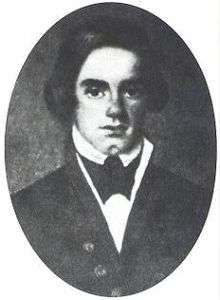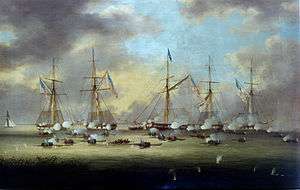Thomas ap Catesby Jones
| Thomas ap Catesby Jones | |
|---|---|
 A young Jones | |
| Born |
April 24, 1790[1] Westmoreland County, Virginia, U.S. |
| Died |
May 30, 1858 (aged 68)[2] Sharon, Virginia, U.S. |
| Buried at | Fairfax, Virginia, U.S. |
| Allegiance |
|
| Service/branch |
|
| Years of service | 1805–1858 |
| Rank |
|
| Commands held |
USS Peacock Pacific Squadron |
| Battles/wars |
Capture of Monterey Mexican-American War |
Thomas ap Catesby Jones (24 April 1790 – 30 May 1858) was a United States Navy officer during the War of 1812 and the Mexican-American War.
Early life and education
Thomas ap Catesby Jones was born on 24 April 1790 in Westmoreland County, Virginia to Catesby and Lettice Turberville Jones. The Jones family had originated in Wales and the middle name "ap Catesby" was a gesture to the patronymic surnames traditionally used in Wales; Thomas ap Catesby in Welsh means "Thomas, son of Catesby".[1]
Jones' father died on 23 September 1801 leaving the family destitute. Jones and his older brother, Roger were taken in by an uncle, Meriwether Jones of Richmond, Virginia. His mother died in December 1804 after a long illness leaving Jones an orphan at age 14. His uncle provided for his and his brother's education at Richmond Academy until the expense of private school became a burden. They studied with a private tutor after leaving the school.[3] Roger Jones would later become Adjutant General of the U.S. Army.[4]
War of 1812

Jones was appointed a midshipman in the U.S. Navy on 22 November 1805 at the age of fifteen but owing to a lack of vacancies for midshipmen, he was not ordered to active duty. He was furloughed home and advised to study geography, navigation, and surveying so that his chances of getting an active assignment would improve. After the Chesapeake–Leopard Affair, the Navy mobilized its gunboats and Jones was ordered to report to Norfork, Virginia where he was assigned to gunboat No. 10, reporting the first week of August 1807.[5] He receiving honors for bravery at the Battle of Lake Borgne, Louisiana, delaying the British before the Battle of New Orleans.[6]
Between wars
In 1826, Commodore Jones while in command of the veteran sloop-of-war Peacock, signed a treaty with Queen regent Kaʻahumanu and other chiefs of the Kingdom of Hawai'i.[7] In 1827, Peacock was severely damaged in an attack by a whale[8] Upon return to New York in October 1827, she was decommissioned and broken up in 1828. She was rebuilt as Peacock (1828), to serve as an exploration ship of the United States Exploring Expedition. Jones was to have commanded the expedition, but lack of funding delayed the expedition until 1838, by which time he had resigned the appointment.
From 1841 to 1844, Jones commanded the United States Pacific Squadron, and again from 1848 to 1850. In 1842, mistakenly thinking that war with Mexico had begun, he seized the California port of Monterey; he held it for one day before returning control to Mexico.[9] Hearing that British Captain Lord George Paulet had seized the Kingdom of Hawaii, he sailed there and arrived July 22, 1843. The king was restored July 31, and Jones tried to hasten peace by hosting all parties to dinner aboard his ship.[10]
In 1843, Jones returned a young deserter, Herman Melville, to the United States from the Sandwich Islands, as the Hawaiian Islands were then known. Later, Melville modeled "Commodore J—" in Moby-Dick, and the commodore in White-Jacket after Jones.[11] In 1827 Peacock under Jones's command had been severely damaged in an attack by a whale, which Melville took to have been a sperm whale.[8] Moby-Dick may have partially inspired the story told of Jones in Chapter 45 "The Affidavit".[12]
By early 1844 Alexander Dallas had replaced Jones as Pacific commander.[10]
Mexican War
In 1848, Jones arrived in Mazatlán just at the end of the Mexican–American War, maintaining order until he could transport those who had aided the United States in that war to Monterey.[13]
Later career
For the next two years, during the chaotic Gold Rush days, Jones provided a U.S. Navy presence in the San Francisco area while the United States debated what to do with the newly acquired California Territory.[14]
In 1850, in a politically charged court-martial shortly after White-Jacket was published, Jones was found guilty on three counts mostly related to "oppression" of junior officers and relieved of command for two-and-a-half years. In 1853, President Millard Fillmore reinstated him and in 1858, the United States Congress restored his pay.[15]
See also
Notes
- Citations
- References used
- Bauer, K. Jack (1969). Surfboats and Horse Marines: U.S. Naval Operations in the Mexican War, 1846–48. Annapolis, Maryland: United States Naval Institute.
- Gapp, Frank W. (1985). "The Kind-Eyed Chief: Forgotten Champion of Hawaii's Freedom". Hawaiian Journal of History. Hawaii Historical Society. 19: 101–121. hdl:10524/235.
- Smith, Gene A. (2000). Thomas ap Catesby Jones. Annapolis, Maryland: Naval Institute Press. ISBN 978-1-55750-848-5.
- Stauffer, Robert H. (2009). "The Hawai'i-United States Treaty of 1826" (pdf). eVols. University of Hawaii at Manoa. Retrieved 5 December 2015.
External links
-
 Media related to Thomas ap Catesby Jones at Wikimedia Commons
Media related to Thomas ap Catesby Jones at Wikimedia Commons